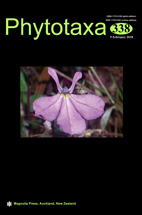Abstract
An arbuscular mycorrhizal fungus (AMF) producing clusters with colourless, small (11‒35 µm diam when globose) spores of unique morphological characters of two spore wall layers was grown in a trap culture and in single-species cultures. Both the spore wall layers are permanent and have the same thickness. The features of the spores prompted that the fungus most probably belongs to one of the genera, Dominikia or Kamienskia. Phylogenetic analyses of sequences of the SSU‒ITS‒LSU nrDNA and the RPB1 gene showed that the discussed AMF is an undescribed Dominikia sp. highly diverged molecularly from the 12 so far described species of the genus. Consequently, the fungus is described here as D. litorea sp. nov. The sporulation of D. litorea in the trap culture indicated that in the field the new species lived in mycorrhizal symbiosis with Xanthium spinosum that had colonized sand dunes of the Mediterranean Sea located near Verico, Greece. However, comparisons of the SSU‒ITS‒LSU sequences of D. litorea with those obtained from molecular environmental studies, which are deposited in public databases, indicated that the new species probably is also associated with roots of an unnamed plant species growing in China. In addition, based on available literature, sequence data and personal observations, the so far known geographical distribution, habitats, and plant-hosts of the described Dominikia spp. were presented and discussed. Finally, the potential participation of Dominikia spp. in influencing plants and plant communities with which they are associated and ecosystems in which they exist were discussed.

